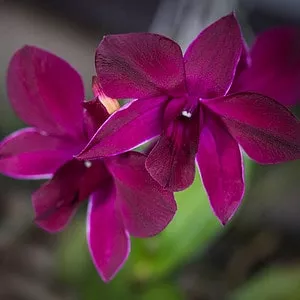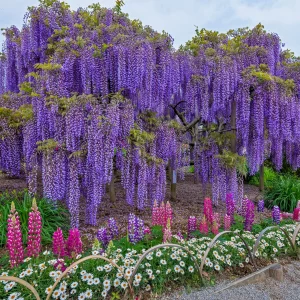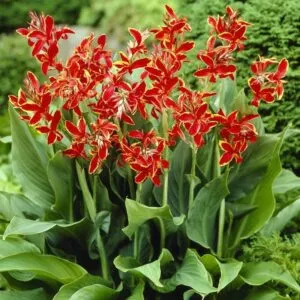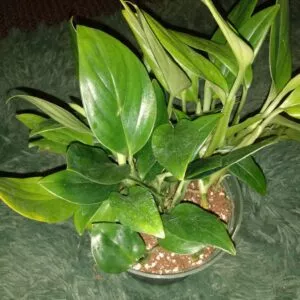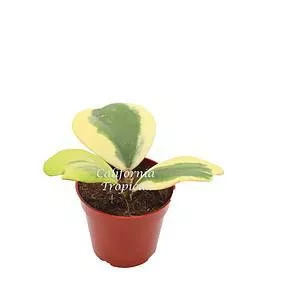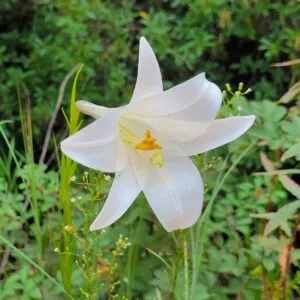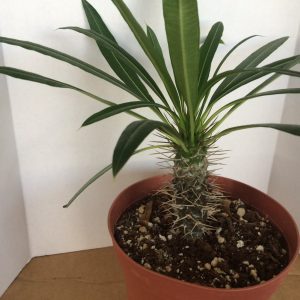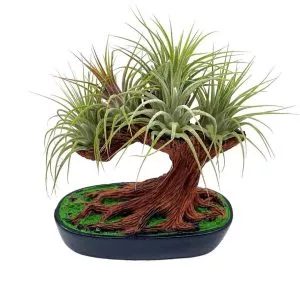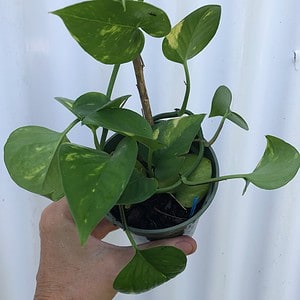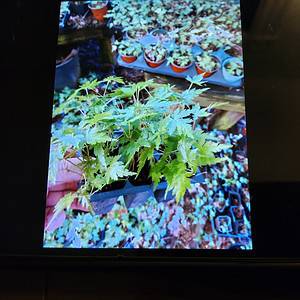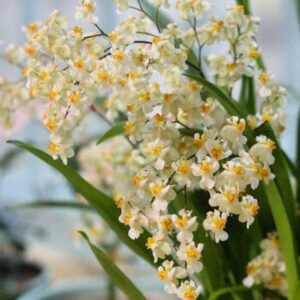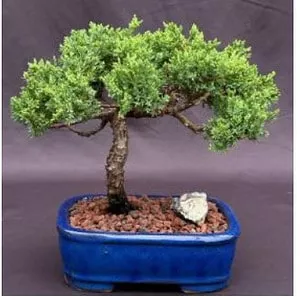No products in the cart.
Table of Contents
Lungwort. What a peculiar name. This rare plant is a bloomer in spring, with its leaves resembling the shape of lungs. One thing is for sure it has attractive foliage with blue flowers made for a shade garden.
Still, did you know that people used it for medicine? Yes, to treat different infections for a diseased lung.
But these days, the outdoor plant you see growing as a perennial in the landscape emerges with flowers when other plants start poking out their heads.
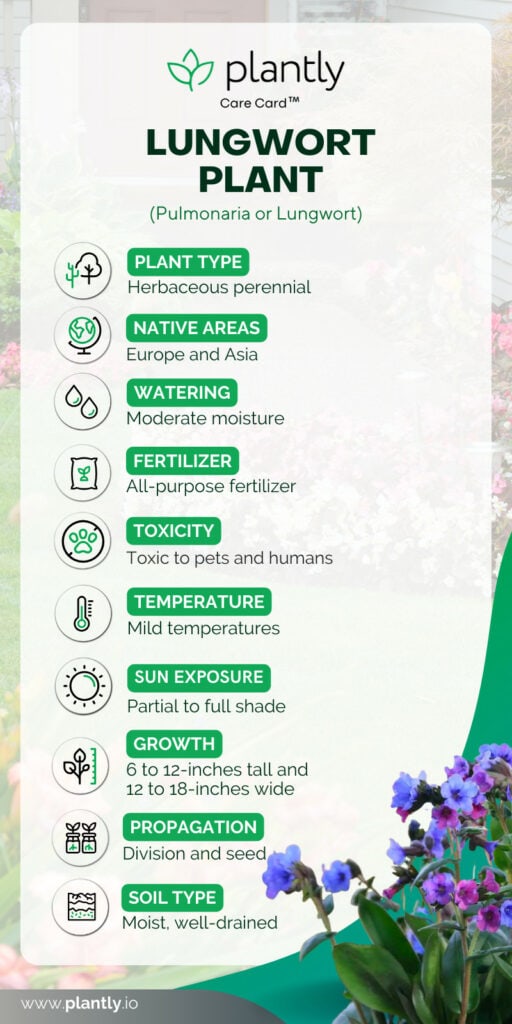
Is it Pulmonaria saccharata or Pulmonaria officinalis?
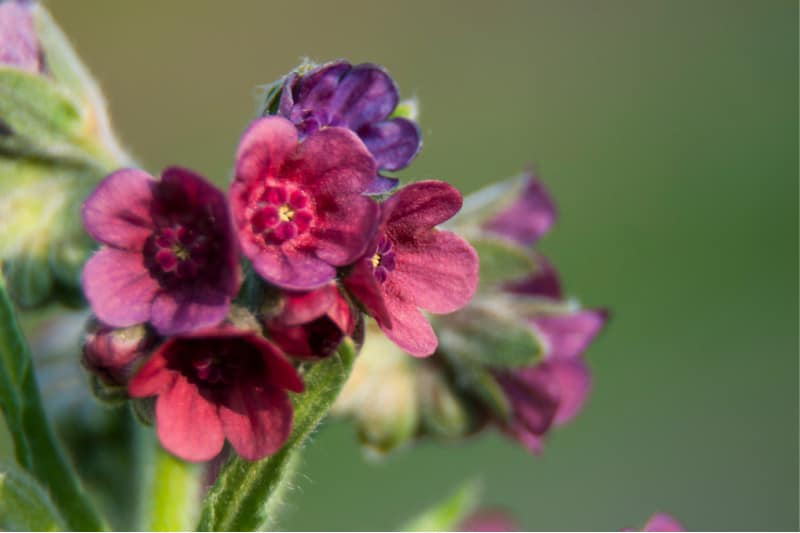
Interestingly enough, both these plants belong to the same genus Pulmonaria. The fact is that the Pulmonaria saccharata is known as the Bethlehem lungwort native to Italy and France.
Meanwhile, the Pulmonaria officinalis is the original Lungwort that many people get confused with P. saccharata.
The Bethlehem lungwort or Bethlehem sage has lance-shaped leaves with white spots and white or pink flowers in early spring. The Lungwort or common Lungwort has basal green foliage that is cordately looking long yet pointed. Still, the leaves have white to pale green patches.
You even notice tiny bumps with a hairy texture. The greenery produces small flowers with five petals in pink or red but turns to a blue-purple shade. Another interesting fact is that the flower consists of a dye that changes from acidic to alkaline causing it to turn from pink to blue.
The plant was first used in 1501-1566 by Leonhart Fuchs, a physician from Germany who is the father of botany. Carl Linnaeus changed the name to P. officinalis for medical reasons used for treating coughs and lung diseases. But these days, the Lungwort your find gardeners growing for aesthetics and not for medical purposes anymore.
Lungwort Plant Care
No matter what species of Pulmonaria you have, care and maintenance are basically the same for both. So, let’s get to taking care of these gorgeous plants with their dark green leaves.
Best Potting Mix to Get Rose Pink Flowers

Your plant thrives in humus and organic-rich soil with ample drainage. The ground has to have a slightly acidic to neutral soil pH level. Nevertheless, Lungwort can also tolerate slightly alkaline soil.
If you grow your plants as a ground cover in clay soil, it helps to add some organic matter to help provide good drainage. The Pulmonaria lungwort plants thrive in moist soil but are not soggy as it can lead to rotting.
Ideal Lighting is Partial Shade
Yes, this is a hardy shade plant tolerating different lighting conditions. Thus, you can grow lungwort in partial or full shade at times.
While it can tolerate some bright light for healthy growth, partial shade works best. Just make sure to prevent harsh sun in the warmer months as the leaves of your plant may get scorched. With too little sun, though, it will not bloom.
In stock In stock In stock
Free Shipping
$39.99
Sold By:
Aloha Hawaii Orchids
$44.99Dendrobium Kratingdaeng Comes in 4″ Pot
Rated 4.65 out of 5 based on 268 customer ratings00
Sold By:
Aloha Hawaii Orchids
Free Shipping
$8.59 – $58.00
Sold By:
CZ Grain
Wisteria Vine Seeds – Highly Prized Flowering Plant for Garden, Yard, or Bonsai, Wisteria sinensis
Rated 4.60 out of 5 based on 156 customer ratings00
Sold By:
CZ Grain
$10.00
Sold By:
Smoot's Farm
Canna Lily Lucifer Dwarf Variety Red One #1 Rhizome Bulbs
Rated 4.89 out of 5 based on 27 customer ratings00
Sold By:
Smoot's Farm
Watering Needs for Dark Green Leaves
When your plant is in the early stages of growth, you can keep the soil moist but well-drained. Once lungwort plants establish, they can tolerate drought to some degree. However, too much heat may cause the plants to dry out, so drizzle water occasionally.
Temperature & Humidity Requirement
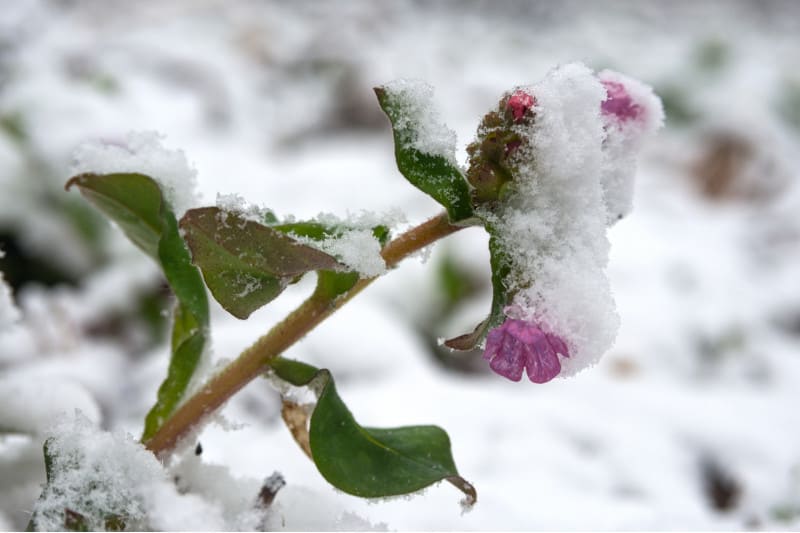
You can grow Lungwort in mild temperatures ranging from 60 to 65°F (15—18°C). They do not flourish in hot and humid climates. Dry weather can result in wilting, but it does perk up as the temperatures become cooler in fall. Once the frost subsides in spring, they start growing again.
Fertilizer Requirement
The lungwort flower is not a heavy feeder, and you can provide an all-purpose garden fertilizer around your plant in early spring. Or, you can mix some compost that is rich in organic matter with the soil to help promote your plant’s growth.
How to Propagate Pulmonaria Spp
The majority of spotted Pulmonaria are hybrids started from seeds. However, the best means of propagation begins with division.
Once your mature plant completes its flowering, you can dig up the plant with the roots intact. Here is how you can do it:
When a mature plant is done flowering, often in late summer or early fall, you can carefully dig up the entire clump while keeping the roots intact.
Wash the roots off with water to remove any dirt.
Pull the clumps apart with the fingers to separate the roots into sections. You can discard the woody sections.
Replant the sections in prepared soil and place them a few feet apart to provide enough air circulation.
Please keep them in a part shade garden, which requires frequent watering until established during dry spells.
Growth Zone

Most species of Lungwort Pulmonaria grow in the USDA hardiness zones six through nine without any problems.
Pruning Several Species of Lungwort
Once the flowering season of Pulmonaria is completed, you will notice the stalks turning brown and start to flop over. The semi-evergreen foliage starts looking tattered. You can remove the stalk and leaves to encourage new growth. Alternatively, you can trim off the leaves degrading from the dry weather or when it is scorching.
In stock In stock Only 1 left in stock In stock
Free Shipping
$39.99
Sold By:
California Tropicals
Hoya Kerrii Variegated 3+Leaves– 4″ from California Tropicals
Only 35 available and it’s in 1 people’s basket Rated 4.96 out of 5 based on 25 customer ratings04
Sold By:
California Tropicals
Free Shipping
$8.00
Sold By:
Chill Hill Farms
Philippine Lily | 100+ Seeds | Lilium Philippinese | Florida Grown
Sold By:
Chill Hill Farms
Free Shipping
$249.59
Sold By:
BONSAI WORLD LLC
Chinese Flowering White Serissa Bonsai Tree of a Thousand Stars
Sold By:
BONSAI WORLD LLC
$29.99
Sold By:
Succulent Oasis
Large Madagascar Palm | A very unique and beautiful cactus
Rated 4.84 out of 5 based on 352 customer ratings00
Sold By:
Succulent Oasis
Lungwort Varieties and Similar Plant Trees
Pulmonaria longifolia
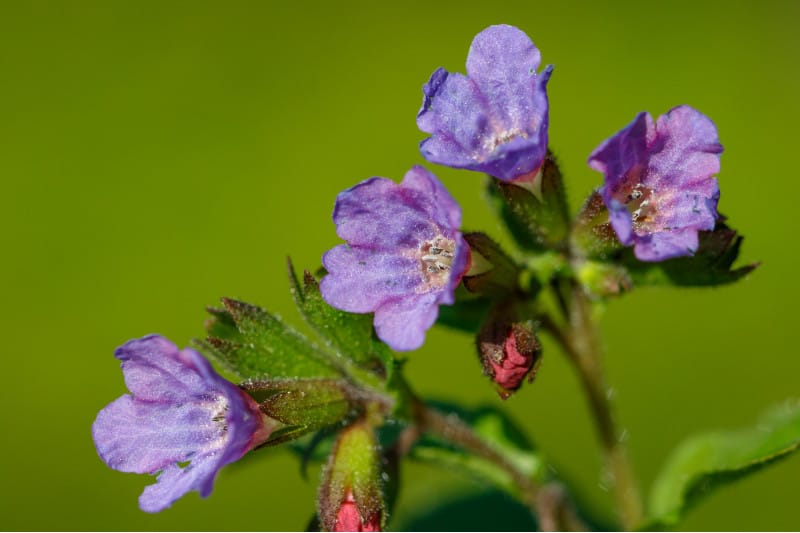
You can grow this plant in the sun, and it has long narrow leaves, and they are mildew resistant. The foliage is known as purple Lungwort.
Pulmonaria rubra
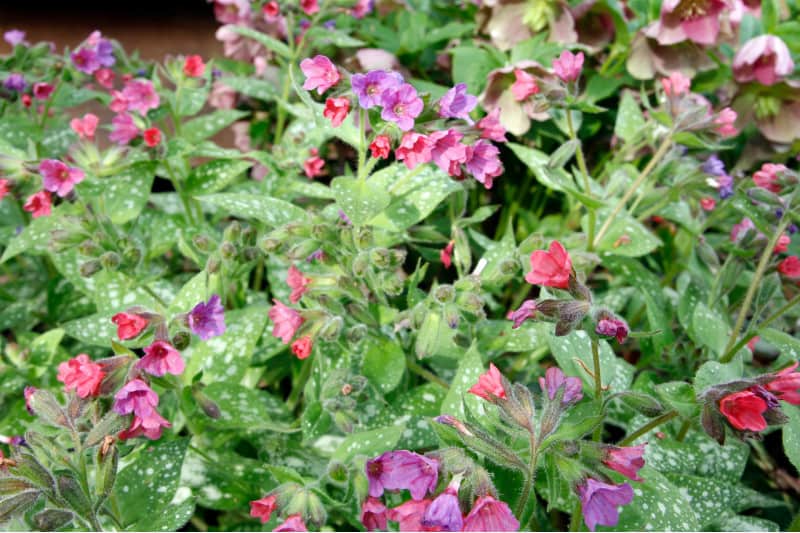
This plant makes for an excellent ground cover for a garden filled with red flowers. The vegetation grows up to one foot but grows best in cooler climates.
Pulmonaria angustifolia or Pulmonaria alba

Many gardeners get confused with this greenery as you can find it in different cultivars growing in humus-rich soil. The foliage is stunning blooming with blue flowers.
Lungwort Diseases & Pests
Your Lungwort is primarily free from pests and diseases. Suppose you grow it in dry soil, powdery mildew forms on the foliage. You can remove the leaves and water them well. Or, you can remove them from the shaded spot and transplant them into well-draining soil in partial sun.
The other concerns that do affect the young shoots are snails and slugs.
In stock In stock In stock In stock
$13.95
Sold By:
SunSoul Plants
$18.95Maranta Red ‘Prayer Plant’ – Maranta leuconeura in 3 or 4″ pot
Only 1 available and it’s in 3 people’s basket Rated 4.87 out of 5 based on 98 customer ratings00
Sold By:
SunSoul Plants
$29.99
Sold By:
BubbleBlooms
Bonsai Air Plant Tree, Air Plant Holder with Live air plants, plant gift
Rated 4.81 out of 5 based on 279 customer ratings00
Sold By:
BubbleBlooms
$20.00
Sold By:
Beauties & Beasts
Cactus- Tephrocactus articulatus var strobiliformis
Only 2 available and it’s in 1 people’s basket Rated 4.83 out of 5 based on 24 customer ratings00
Sold By:
Beauties & Beasts
Free Shipping
$12.95
Sold By:
SunSoul Plants
$17.95Golden Pothos, Epipremnum Aureum in 3″ pot, Devil’s ivy, free shipping
Only 3 available and it’s in 2 people’s basket Rated 4.87 out of 5 based on 98 customer ratings00
Sold By:
SunSoul Plants
Cheat Sheet for Lungwort
- When choosing between Lungwort species, choose a Lungwort evergreen with spotted, plain, or splashed with all silver and a gorgeous green rim.
- The blue, and pink varieties look jewel-like in early spring and work well with your bulbs, like dogs’ tooth violet.
- Growing white Lungwort in the shade glows and provides a bright green euphorbia when it re-wakens. Consider the Moonshine or the Sissinghurst White that has silvered leaves.
Keeping Them Alive
- You can divide your vegetation in summer as some even self-seed. Then, you can reposition them into the ground in a cool woodland spot.
- Remember the humus-rich ground as rotting leaves allow your Lugwort to thrive.
- If the environment is too dry, you notice powdery mildew forming on the leaves.
Frequently Asked Questions
It all depends on the Pulmonaria plant you have as some such as the common Lungwort is toxic while the Pulmonaria saccharata has no notes of toxicity.
People use Lungwort for the stomach, intestinal, and treating breathing conditions. Manufacturers use it in cough medicines, but we do not recommend you use just any part of the foliage as some are toxic to humans and pets.
The leaves on the Lungwort Mertensia Maritima you can consume raw or cooked. The foliage has a mild but pleasant taste. Hence, you can eat the leaves with eggs in a salad. Further, the flowers and taproots on this specific species are edible.
As most varieties, for example, the Pulmonaria Roy Davidson and others, are hybrids collecting seed is not true to the parent plant type. The best way to grow new plants is through division, as these plants self-seed.
When you grow lungwort plants during winter, the best is to cover them with mulch after the ground freezes. It will help moderate the freeze and thaw cycles to ensure the roots remain warm during the cold.
When you grow Pulmonaria, it is not invasive, but it can gradually spread with the rhizomes and works well as ground cover.
Whether you want to buy, sell or simply reach out to other plant enthusiasts, Plantly is the right place to be!
In stock In stock Only 1 left in stock In stock
$18.95
Sold By:
Willows Bonsai
6 pack Japanese Maples Great for Bonsai or Nursery Stock
Sold By:
Willows Bonsai
Free Shipping
$34.99
Sold By:
Aloha Hawaii Orchids
$39.99Live Oncidium Twinkle ‘White’ ‘Gold Dust’ Orchid from Hawaii | Tropical Hawaiian Exotic Plant
Rated 4.65 out of 5 based on 268 customer ratings01
Sold By:
Aloha Hawaii Orchids
Free Shipping
$186.89
Sold By:
BONSAI WORLD LLC
Juniper Bonsai Tree – Trained (juniper procumbens nana)
Only 1 available and it’s in 1 people’s basket
Sold By:
BONSAI WORLD LLC
$14.95
Sold By:
SunSoul Plants
$19.95Peperomia clusiifolia Red Edge in 3″ pot
Only 2 available and it’s in 1 people’s basket Rated 4.87 out of 5 based on 98 customer ratings00
Sold By:
SunSoul Plants
